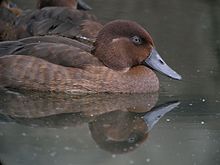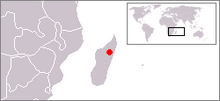Aythya innotata
| Madagascan pochard | |
|---|---|
 |
|
| Madagascan pochard, Captive Breeding Program, Madagascar | |
| Scientific classification | |
| Kingdom: | Animalia |
| Phylum: | Chordata |
| Class: | Aves |
| Order: | Anseriformes |
| Family: | Anatidae |
| Subfamily: | Aythyinae |
| Genus: | Aythya |
| Species: | A. innotata |
| Binomial name | |
|
Aythya innotata (Salvadori, 1894) |
|
 |
|
| Former range (in red) | |
| Synonyms | |
|
Nyroca innotata Salvadori, 1894 (basionym) |
|
Nyroca innotata Salvadori, 1894 (basionym)
The Madagascan pochard or Madagascar pochard (Aythya innotata; Malagasy: Fotsy maso, Onjo) is an extremely rare diving duck of the genus Aythya. Thought to be extinct in the late 1990s, specimens of the species were rediscovered at Lake Matsaborimena in Madagascar in 2006. As of March 2013, the population is around 80 individuals.
Based on the accounts written by Webb and Delacour's in the 1920s and 1930s it seemed that the bird was still relatively common at Lake Alaotra. The duck probably started to decline dramatically sometime in the late 1940s or early 1950s. The cause of decline was the introduction of numerous fish species in the lake that killed most of the pochard chicks and damaged nesting sites. Adult birds are also likely to have become victims of introduced fishes. Rice cultivation, cattle grazing on the shores, burning of shore vegetation, introduced mammals (rats), gill-net fishing and hunting are all factors that led to the duck's disappearance from the lake. The last record of multiple birds at Lake Alaotra is from 9 June 1960 when a small flock of about 20 birds was spotted on the lake. Despite the rarity of the species in 1960, a male was shot, and the specimen is now held by the Zoological Museum Amsterdam. There is a very dubious report of a sighting made outside Antananarivo in 1970.
Before it was rediscovered in 2006, the last confirmed sighting of the species was at Lake Alaotra on the Central Plateau of Madagascar in 1991. The single male then encountered was captured and kept in the Antananarivo Botanical Gardens until it died one year later. Intensive searches and publicity campaigns in 1989–1990, 1993–1994 and 2000–2001 failed to produce any more records of this bird.
However, a flock of nine adults and four recently hatched ducklings were discovered at Lake Matsaborimena, in a remote area of northern Madagascar, in November 2006. The species was placed in the new "Possibly Extinct" category in the 2006 IUCN Red List; following the rediscovery, its old status of Critically Endangered was restored in the 2007 issue. As of 2008, only 25 adult birds had been counted in the wild.
...
Wikipedia

